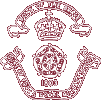


 |
 |
|
 |
||
| Navigation links at the bottom of this page | |||||||||||||||||||||
| Collection of GC medals | |||||||||||||||||||||
Editor's note: other medals awarded to boys of the RMA and Duke of York's School are to be found in the book by David Harris "A Guide to Military Temperance Medals" second edition. The year 1850 marked the first award of a Good Conduct medal to boys of the RMA. Unlike the award of temperance medals, which recipients wore on the left breast when in uniform but not on parade, GC medals were officially recognized and could be worn along with campaign and award medals a soldier earned during his service. The RMA GC medal has been awarded annually since it was first issued in 1850 The medal obverse is described as the royal arms, garnished, crested
and with supporters; the medal reverse is described as ROYAL MILITARY
ASYLUM or DUKE OF YORK’S ROYAL MILITARY SCHOOL around the circumference
enclosing a laurel wreath inscribed across the centre FOR GOOD CONDUCT.
The medal is fitted with a scrolled suspender and brooch. The edge is
engraved in upright capitals with the name of the recipient (British
Token publishers Medal Yearbook). The ribbon in the Medal Yearbook (which is for the RMA) is described as Plain Red. However, of the three medals in the possession of the author, all DYRMS, one is suspended by a red ribbon, one by a crimson ribbon (similar to the 19th Century [pre-1917 issue] Regular Army Long Service & Good Conduct) and one from a green ribbon. |
|||||||||||||||||||||
|
|||||||||||||||||||||
On the DYRMS web site under ‘1909 Making a New Start’ the school photographic album for that period shows under the photograph entitled ‘The Monitors’ a total of 3 medal wearers in the front row; 1 medal wearer in the centre row and 2 medal wearers in the rear row. This gives a total of 6 medals being worn in 1909. On the same site it is possible to make out 2 medal wearers in the photograph of A Company and 1 each in B, E and G Company, with 1 missing. In the photograph showing the Colour Party the King’s Colour Bearer is also wearing a medal. All medals shown appear to be of the silver variety. This would appear to dispel the supposition that only one medal was awarded per year as is, reportedly, current practise. The Bursar of the school in 2001, Lieutenant Colonel Roger Say, in a reply to a letter seeking information on the Good Conduct medal, stated that: ‘The DYRMS Good Conduct Medal is awarded annually to two pupils for their overall contribution to the school. It is awarded as a bronze and silver medallion, the silver normally to the Chief School Prefect (CSP). In my time at the school the Chief School Prefect also commanded when the school was on parade, although I confess I cannot recall his ‘parade’ rank. With the above information Lt. Col. Say also included a DYRMS Prospectus and a ‘Winter 2001’ copy of ‘Dispatches,’ the school newsletter. A photograph in this shows Senior Under Officer James Barton on the Remembrance Sunday Parade, without evidence of a medal. In the Medal Yearbook 2004 the value is shown as £400-450
for the Royal Military Asylum Good Conduct medal. This is revised in Medal
Yearbook 2005 to £100-150. In Morton & Eden (In Association
with Sotheby’s) May 2006 Auction a RMA Good Conduct medal
(named to T. LEONARD) on a crimson ribbon estimated
at £100-150 sold for £240. In a Dix, Noonan & Webb Auction
in April 2006 a Gordon Boys Home Medal for Exemplary Conduct, silver
(named to 2310 Corpl. F. H. TRIMMER);
The Gordon Boys School Medal for Exemplary Conduct, silver (unnamed)
and a Duke of York’s Royal Military School Good conduct Medal,
silver (named to Colour Corporal E. ELLIOT) with a silver
buckle on the ribbon, estimated at £60-80 sold for £160.
Unfortunately, no illustration was available. |
|||||||||||||||||||||
| ||||||||||
|
© A. W. Cockerill 2011 Site Map Contact me | ||||||||||